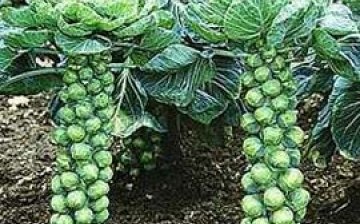Growing Brussels sprouts
Growing Brussels sprouts is a pleasant process, but requires some preparation. Brussels sprouts are not common among our gardeners, rather because it is too specific for our people, than because of the difficulties of growing.
Brussels sprouts are a treasure trove of nutritional and palatability, they are full of vitamin C and are well suited for dietary nutrition. Brussels sprouts look like white cabbage in miniature.
The cultivation of Brussels sprouts should be started in April if you sow seeds directly into the ground under a film or in June if you are planting ready-made seedlings. It is better to plant Brussels sprouts in the places where legumes, cucumbers or tomatoes used to grow.
If you are planting cabbage in a new place, then it is necessary to prepare a bed, that is, add humus, ash or chalk, nitrophosphate to the ground and water the bed with potassium permanganate. Seed shoots appear quickly, at a temperature of 18 degrees, on the third day. Seedlings must be planted with three to five leaves, for better growth and ovary heads, it is better to break off the top.
If the seedlings appear relatively quickly, then the growth of Brussels sprouts is slow, therefore, cucumbers, tomatoes or other vegetables are often grown in the aisles with cabbage. Brussels sprouts do not need to be hilled, weeds need to be removed, while watering and feeding it.
At the end of summer, heads of cabbage begin to form, and the leaves begin to turn yellow and fall off, at a time when the heads of cabbage begin to thicken, the top of the cabbage stalk must be pinched again. Brussels sprouts are usually harvested together with the stem until November, so that the cabbage can be stored, since without the stem, the cabbage quickly withers, and with the stem it can be stored for about two months if it is placed in a bag and removed where the temperature is not below zero, but and not more than two degrees.



